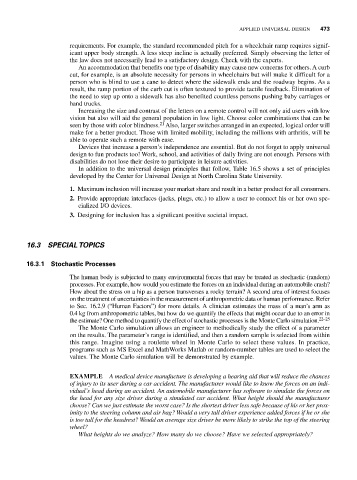Page 495 - Biomedical Engineering and Design Handbook Volume 2, Applications
P. 495
APPLIED UNIVERSAL DESIGN 473
requirements. For example, the standard recommended pitch for a wheelchair ramp requires signif-
icant upper body strength. A less steep incline is actually preferred. Simply observing the letter of
the law does not necessarily lead to a satisfactory design. Check with the experts.
An accommodation that benefits one type of disability may cause new concerns for others. A curb
cut, for example, is an absolute necessity for persons in wheelchairs but will make it difficult for a
person who is blind to use a cane to detect where the sidewalk ends and the roadway begins. As a
result, the ramp portion of the curb cut is often textured to provide tactile feedback. Elimination of
the need to step up onto a sidewalk has also benefited countless persons pushing baby carriages or
hand trucks.
Increasing the size and contrast of the letters on a remote control will not only aid users with low
vision but also will aid the general population in low light. Choose color combinations that can be
21
seen by those with color blindness. Also, larger switches arranged in an expected, logical order will
make for a better product. Those with limited mobility, including the millions with arthritis, will be
able to operate such a remote with ease.
Devices that increase a person’s independence are essential. But do not forget to apply universal
design to fun products too! Work, school, and activities of daily living are not enough. Persons with
disabilities do not lose their desire to participate in leisure activities.
In addition to the universal design principles that follow, Table 16.5 shows a set of principles
developed by the Center for Universal Design at North Carolina State University.
1. Maximum inclusion will increase your market share and result in a better product for all consumers.
2. Provide appropriate interfaces (jacks, plugs, etc.) to allow a user to connect his or her own spe-
cialized I/O devices.
3. Designing for inclusion has a significant positive societal impact.
16.3 SPECIAL TOPICS
16.3.1 Stochastic Processes
The human body is subjected to many environmental forces that may be treated as stochastic (random)
processes. For example, how would you estimate the forces on an individual during an automobile crash?
How about the stress on a hip as a person transverses a rocky terrain? A second area of interest focuses
on the treatment of uncertainties in the measurement of anthropometric data or human performance. Refer
to Sec. 16.2.9 (“Human Factors”) for more details. A clinician estimates the mass of a man’s arm as
0.4 kg from anthropometric tables, but how do we quantify the effects that might occur due to an error in
the estimate? One method to quantify the effect of stochastic processes is the Monte Carlo simulation. 22–25
The Monte Carlo simulation allows an engineer to methodically study the effect of a parameter
on the results. The parameter’s range is identified, and then a random sample is selected from within
this range. Imagine using a roulette wheel in Monte Carlo to select these values. In practice,
programs such as MS Excel and MathWorks Matlab or random-number tables are used to select the
values. The Monte Carlo simulation will be demonstrated by example.
EXAMPLE A medical device manufacture is developing a hearing aid that will reduce the chances
of injury to its user during a car accident. The manufacturer would like to know the forces on an indi-
vidual’s head during an accident. An automobile manufacturer has software to simulate the forces on
the head for any size driver during a simulated car accident. What height should the manufacturer
choose? Can we just estimate the worst case? Is the shortest driver less safe because of his or her prox-
imity to the steering column and air bag? Would a very tall driver experience added forces if he or she
is too tall for the headrest? Would an average size driver be more likely to strike the top of the steering
wheel?
What heights do we analyze? How many do we choose? Have we selected appropriately?

